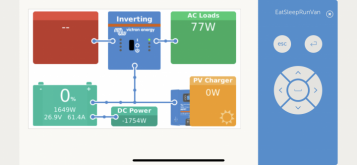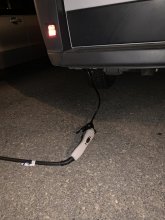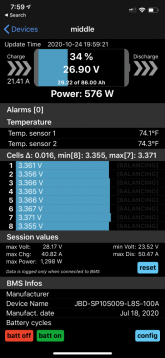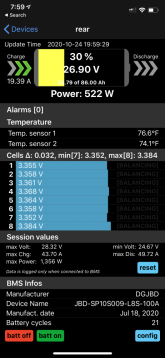berksrunner
New Member
- Joined
- Jul 27, 2020
- Messages
- 122
I've been thinking about this for a while, with a couple of false starts over the past year and a half, but I think I finally have the necessary pieces to make this a reality for my van system (DIY lifepo4, 24V configured as 3 parallel 8S batteries, total of 6.2kwh, Overkill BMS for each 8S battery).
Here's the equipment which I have ordered and am eagerly waiting to have delivered:
1. J1772 to NEMA 5-15 receptacle
2. Mean Well 1500W 240VAC to 27V Switching PSU with enclosure
Yes, it does seem odd to use a NEMA 5-15 for 240VAC (and most certainly non-compliant), but I believe, for a short run, the important thing will be whether my wire gauge is adequate, which it most certainly will be since 1500W (or less) @240V is obviously pretty low current. And, of course, I can't make any mistakes -- I've got to make sure the Mean Well unit is at the other end of that wire, or else something is going to fry.
I plan to use 6AWG between the Mean Well and my bus bars, and I'll likely set the voltage at around 28.8.
I'm excited about this, because I've got an electric water heater which is fine in summer, but as winter approaches, the solar is a bit harder to come by, and I hate paying for a campground just to charge my batteries. I am constantly driving by extremely sparsely-used EV charging stations here in Colorado, and it just seems like an enormous waste....plus I'm happy to pay for the 30-45 mins of charging that I'll need to get me over the top on a day when I want to take a nice hot shower in my van.
Any thoughts?
Here's the equipment which I have ordered and am eagerly waiting to have delivered:
1. J1772 to NEMA 5-15 receptacle
Amazon.com: Mean Well RSP-1500-27 Enclosed Switching AC-to-DC Power Supply, Single Output, 27V, 0-56A, 1512W, 3.3" H x 5.0" W x 10.9" L : Electronics
Buy Mean Well RSP-1500-27 Enclosed Switching AC-to-DC Power Supply, Single Output, 27V, 0-56A, 1512W, 3.3" H x 5.0" W x 10.9" L: Uninterruptible Power Supply (UPS) - Amazon.com ✓ FREE DELIVERY possible on eligible purchases
www.amazon.com
Yes, it does seem odd to use a NEMA 5-15 for 240VAC (and most certainly non-compliant), but I believe, for a short run, the important thing will be whether my wire gauge is adequate, which it most certainly will be since 1500W (or less) @240V is obviously pretty low current. And, of course, I can't make any mistakes -- I've got to make sure the Mean Well unit is at the other end of that wire, or else something is going to fry.
I plan to use 6AWG between the Mean Well and my bus bars, and I'll likely set the voltage at around 28.8.
I'm excited about this, because I've got an electric water heater which is fine in summer, but as winter approaches, the solar is a bit harder to come by, and I hate paying for a campground just to charge my batteries. I am constantly driving by extremely sparsely-used EV charging stations here in Colorado, and it just seems like an enormous waste....plus I'm happy to pay for the 30-45 mins of charging that I'll need to get me over the top on a day when I want to take a nice hot shower in my van.
Any thoughts?









